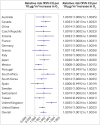Short term association between ozone and mortality: global two stage time series study in 406 locations in 20 countries
- PMID: 32041707
- PMCID: PMC7190035
- DOI: 10.1136/bmj.m108
Short term association between ozone and mortality: global two stage time series study in 406 locations in 20 countries
Abstract
Objective: To assess short term mortality risks and excess mortality associated with exposure to ozone in several cities worldwide.
Design: Two stage time series analysis.
Setting: 406 cities in 20 countries, with overlapping periods between 1985 and 2015, collected from the database of Multi-City Multi-Country Collaborative Research Network.
Population: Deaths for all causes or for external causes only registered in each city within the study period. MAIN OUTCOME MEASURES: Daily total mortality (all or non-external causes only).
Results: A total of 45 165 171 deaths were analysed in the 406 cities. On average, a 10 µg/m3 increase in ozone during the current and previous day was associated with an overall relative risk of mortality of 1.0018 (95% confidence interval 1.0012 to 1.0024). Some heterogeneity was found across countries, with estimates ranging from greater than 1.0020 in the United Kingdom, South Africa, Estonia, and Canada to less than 1.0008 in Mexico and Spain. Short term excess mortality in association with exposure to ozone higher than maximum background levels (70 µg/m3) was 0.26% (95% confidence interval 0.24% to 0.28%), corresponding to 8203 annual excess deaths (95% confidence interval 3525 to 12 840) across the 406 cities studied. The excess remained at 0.20% (0.18% to 0.22%) when restricting to days above the WHO guideline (100 µg/m3), corresponding to 6262 annual excess deaths (1413 to 11 065). Above more lenient thresholds for air quality standards in Europe, America, and China, excess mortality was 0.14%, 0.09%, and 0.05%, respectively.
Conclusions: Results suggest that ozone related mortality could be potentially reduced under stricter air quality standards. These findings have relevance for the implementation of efficient clean air interventions and mitigation strategies designed within national and international climate policies.
Published by the BMJ Publishing Group Limited. For permission to use (where not already granted under a licence) please go to http://group.bmj.com/group/rights-licensing/permissions.
Conflict of interest statement
Competing interests: All authors have completed the ICMJE uniform disclosure form at www.icmje.org/coi_disclosure.pdf and declare: support from UK Medical Research Council, China Medical Board Collaborating Program, Fundação para a Ciência e a Tecnologia, Spanish Ministry of Economy, Industry and Competitiveness, German Federal Ministry of Education and Research, Czech Science Foundation, Estonian Ministry of Education and Research, Japanese Society for the Promotion of Science, Australian National Health and Medical Research Council, Science and Technology Commission of Shanghai Municipality, Global Research Laboratory, through the National Research Foundation of Korea, Future Planning and Korea Ministry of Environment, CSIR parliamentary grant, and the National Institute of Environmental Health Sciences funded HERCULES Centre; no financial relationships with any organisations that might have an interest in the submitted work in the previous three years; no other relationships or activities that could appear to have influenced the submitted work.
Figures



References
-
- Samet JM, Zeger SL, Dominici F, et al. The National Morbidity, Mortality, and Air Pollution Study. Part II: Morbidity and mortality from air pollution in the United States. Res Rep Health Eff Inst 2000;94:5-70, discussion 71-9. - PubMed
-
- EPA. Integrated Science Assessment for Ozone and Related Photochemical Oxidants. https://www.epa.gov/isa/integrated-science-assessment-isa-ozone-and-rela... (accessed 10 Sep 2019).
-
- Health risks of air pollution in Europe - HRAPIE. Health risks of air pollution in Europe –HRAPIE project. http://www.euro.who.int/__data/assets/pdf_file/0006/238956/Health_risks_... (accessed 12 December 2018).
